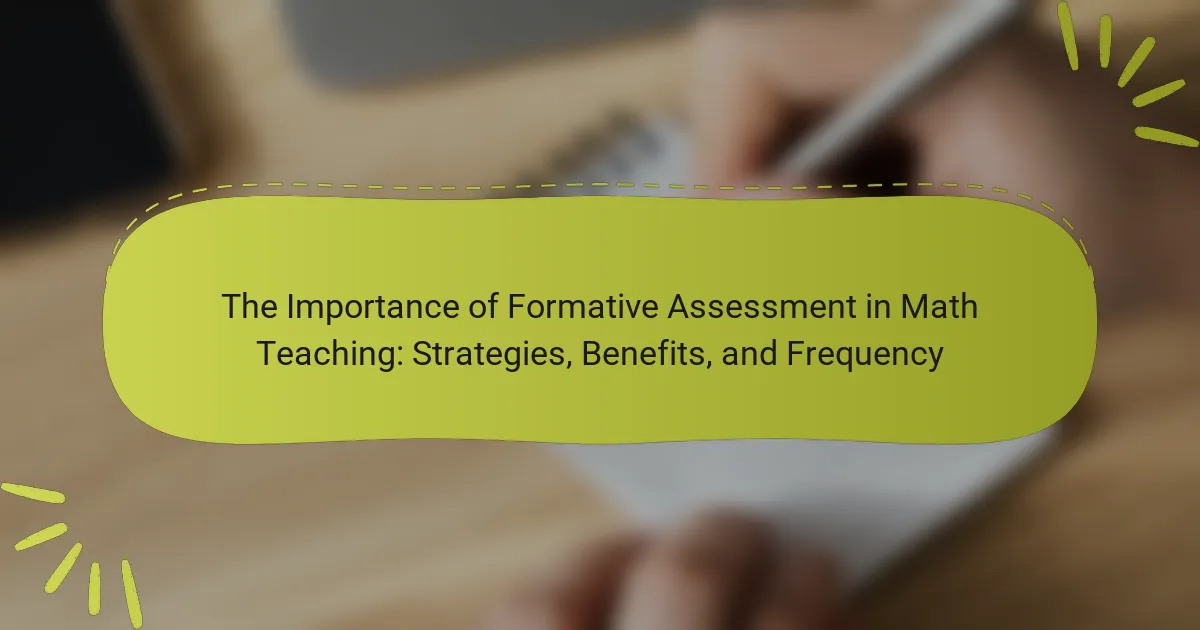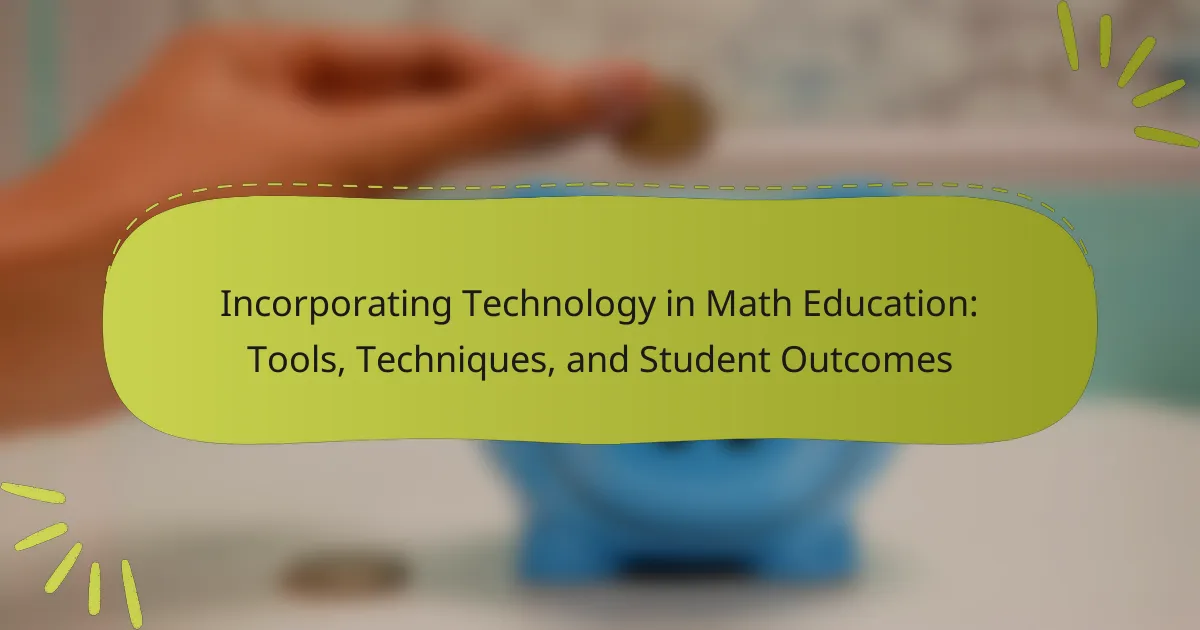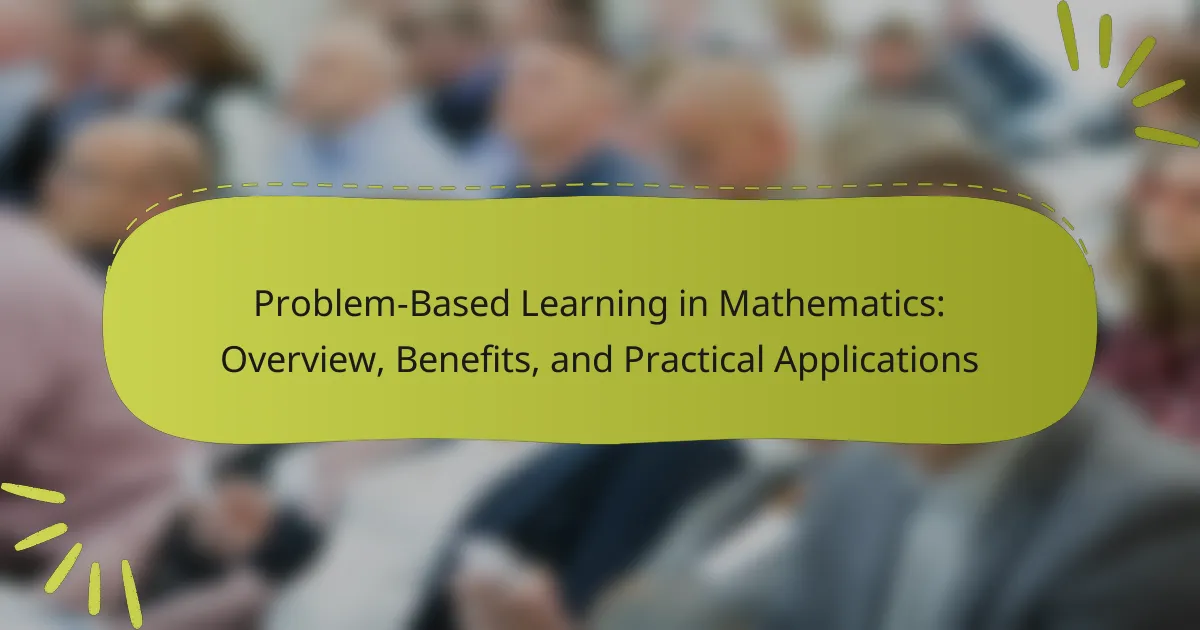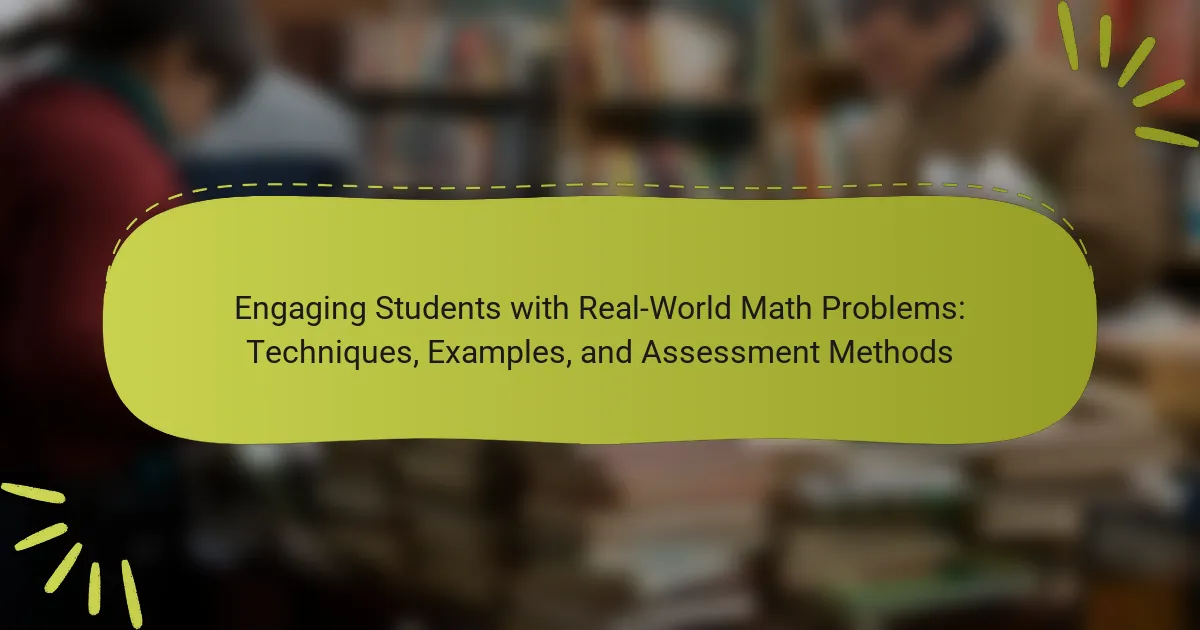Effective strategies for teaching algebra focus on enhancing student engagement and comprehension through various methods. Key techniques include the use of visual aids, such as graphs and diagrams, which help clarify abstract concepts. Real-world applications, drawn from fields like finance and engineering, make algebra more relatable and interesting for students. Additionally, interactive technology, including algebra software and apps, supports personalized learning experiences. Collaborative learning environments promote peer interaction and discussion, further aiding student understanding. Research indicates that employing diverse teaching methods significantly improves students’ retention and mastery of algebraic concepts.

What are Effective Strategies for Teaching Algebra?
Effective strategies for teaching algebra include using visual aids, real-world applications, and interactive technology. Visual aids, such as graphs and diagrams, help students understand abstract concepts. Real-world applications make algebra relevant and engaging. For instance, using examples from finance or engineering can spark interest. Interactive technology, like algebra software or apps, fosters engagement and allows for personalized learning. Additionally, collaborative learning encourages peer support and discussion. Research shows that students benefit from diverse teaching methods, enhancing comprehension and retention.
How can teachers identify the needs of their algebra students?
Teachers can identify the needs of their algebra students through various assessment methods. These methods include formative assessments, such as quizzes and classwork, which provide immediate feedback on student understanding. Additionally, teachers can use diagnostic assessments at the beginning of the course to determine students’ prior knowledge and skills. Observations during class discussions and group work can also reveal students’ engagement and comprehension levels.
Moreover, one-on-one conversations with students can uncover specific challenges they face. Analyzing homework performance helps identify common areas of difficulty. Utilizing standardized tests can provide benchmarks for student performance compared to peers. Finally, soliciting feedback from students about their learning experiences can guide teachers in addressing individual needs effectively.
What assessment methods help in understanding student needs?
Formative assessments help in understanding student needs. These assessments include quizzes, observations, and discussions. They provide immediate feedback on student comprehension. This feedback allows educators to adjust instruction accordingly. Standardized tests also offer insights into student performance levels. They can identify gaps in knowledge across a wider population. Surveys can gather student perspectives on their learning experiences. This qualitative data can highlight individual and group needs. Using a combination of these methods enhances understanding of student requirements.
How does student background influence learning strategies?
Student background significantly influences learning strategies. Factors such as socioeconomic status, cultural background, and prior educational experiences shape how students approach learning. For instance, students from higher socioeconomic backgrounds may have access to more resources, leading to different study habits. Cultural backgrounds can affect students’ motivation and engagement with the material. Research shows that students with diverse educational experiences may adopt varied learning strategies to cope with challenges. A study by the National Center for Education Statistics (NCES) indicates that students’ backgrounds can predict their academic performance and preferred learning methods. Understanding these influences allows educators to tailor their teaching strategies effectively.
Why is engagement important in teaching algebra?
Engagement is crucial in teaching algebra because it enhances student understanding and retention. When students are actively engaged, they are more likely to participate and ask questions. This interaction leads to deeper comprehension of algebraic concepts. Research indicates that engaged students perform better academically. For instance, a study by the National Institute for Student Engagement found that active learning strategies improve student outcomes. Furthermore, engagement fosters a positive learning environment. This environment encourages collaboration and critical thinking skills. Overall, engagement directly impacts students’ success in mastering algebra.
What are the psychological aspects of student engagement?
The psychological aspects of student engagement include motivation, self-efficacy, and emotional connection. Motivation drives students to participate actively in their learning. Self-efficacy relates to students’ belief in their capabilities to succeed. Emotional connection fosters a sense of belonging and investment in the educational environment. Research shows that high levels of engagement correlate with improved academic performance. For instance, a study by Fredricks, Blumenfeld, and Paris (2004) highlights that engaged students exhibit higher persistence and better learning outcomes. These psychological factors are crucial in creating an effective learning atmosphere.
How does engagement impact learning outcomes in algebra?
Engagement significantly enhances learning outcomes in algebra. Engaged students demonstrate higher motivation and persistence. They are more likely to participate actively in class discussions and collaborative activities. Research shows that active engagement leads to deeper understanding of algebraic concepts. According to a study by Fredricks, Blumenfeld, and Paris (2004), engaged students achieve better academic performance. This is particularly evident in problem-solving and critical thinking skills. Higher engagement levels also correlate with improved retention of algebraic knowledge. Overall, increased engagement fosters a positive learning environment that supports student success in algebra.
What techniques can enhance algebra teaching effectiveness?
Interactive learning techniques enhance algebra teaching effectiveness. These techniques include collaborative problem-solving, where students work in pairs or groups. This approach fosters discussion and deeper understanding. Incorporating technology, such as algebra software and online resources, increases engagement. Visual aids, like graphs and charts, help students grasp abstract concepts. Real-world applications of algebra make the content relatable and relevant. Formative assessments provide ongoing feedback, allowing for adjustments in teaching strategies. Research shows that these methods improve student performance and retention in algebra.
How can collaborative learning improve understanding of algebra concepts?
Collaborative learning enhances understanding of algebra concepts by allowing students to engage in peer discussions. This interaction promotes deeper comprehension through the exchange of diverse perspectives. Students can clarify doubts by explaining concepts to each other. Research shows that collaborative learning can lead to improved problem-solving skills. A study by Johnson and Johnson (1999) found that students in collaborative settings perform better academically. Additionally, working in groups fosters a sense of accountability among peers. This encourages individuals to contribute actively to the learning process. Ultimately, collaborative learning creates a supportive environment that strengthens algebraic understanding.
What role does technology play in teaching algebra effectively?
Technology enhances the teaching of algebra by providing interactive tools and resources. These tools include software programs, online platforms, and applications that facilitate learning. They allow for visual representations of algebraic concepts, making abstract ideas more tangible. For instance, graphing calculators and dynamic geometry software help students visualize equations and functions.
Additionally, technology enables personalized learning experiences. Adaptive learning programs adjust difficulty levels based on student performance. This tailored approach helps address individual learning needs and paces.
Furthermore, technology fosters collaboration among students. Online forums and collaborative platforms encourage discussion and problem-solving. This interaction can lead to deeper understanding and retention of algebraic concepts.
Research indicates that technology integration in math education improves student engagement and achievement. A study by the U.S. Department of Education found that technology can enhance learning outcomes when effectively implemented. Thus, technology plays a crucial role in teaching algebra effectively by improving understanding, personalization, and collaboration.
How can teachers incorporate tools to aid algebra learning?
Teachers can incorporate tools to aid algebra learning by utilizing technology and manipulatives. Digital tools like graphing calculators and algebra software provide interactive experiences. These tools help visualize complex concepts. Manipulatives such as algebra tiles allow for hands-on learning. They facilitate understanding of abstract ideas. Additionally, online platforms offer practice problems and tutorials. These resources provide immediate feedback to students. Research shows that technology integration improves student engagement and performance in mathematics. For example, a study by the National Mathematics Advisory Panel indicates that technology can enhance problem-solving skills.
What are the best digital tools for teaching algebra?
The best digital tools for teaching algebra include Khan Academy, Desmos, and GeoGebra. Khan Academy offers comprehensive video tutorials and practice exercises tailored for various algebra topics. Desmos provides an interactive graphing calculator that helps visualize algebraic concepts. GeoGebra combines geometry, algebra, and calculus in an interactive platform for exploring mathematical ideas. These tools are widely used in educational settings and have been shown to enhance student understanding and engagement in algebra.
How can manipulatives be used to teach algebra concepts?
Manipulatives can be used to teach algebra concepts by providing hands-on experiences that enhance understanding. These tools help students visualize abstract concepts like variables and equations. For example, algebra tiles can represent positive and negative values, allowing learners to physically manipulate them to solve equations. Additionally, using blocks or counters can illustrate the distributive property and combine like terms. Research shows that students who engage with manipulatives often demonstrate improved problem-solving skills and conceptual understanding. A study by Clements and Sarama (2009) found that manipulatives significantly enhance mathematical learning when integrated into lessons.
What strategies can be used to maintain student engagement in algebra?
Incorporating interactive activities is a key strategy to maintain student engagement in algebra. Activities such as group work and hands-on problem-solving foster collaboration. Using technology, like algebra software or apps, enhances learning experiences. Real-world applications of algebra concepts make lessons relevant and interesting. Frequent formative assessments provide instant feedback and keep students motivated. Differentiated instruction addresses diverse learning styles and paces. Incorporating games and competitions can make learning fun and engaging. Finally, building a positive classroom environment encourages participation and enthusiasm for algebra.
How can real-world applications of algebra be integrated into lessons?
Real-world applications of algebra can be integrated into lessons through practical examples and problem-solving activities. Teachers can use scenarios such as budgeting, cooking, or construction to illustrate algebraic concepts. For instance, calculating costs for ingredients in a recipe can demonstrate the use of variables and equations. Incorporating technology, like graphing software, allows students to visualize data trends and relationships. Real-life data sets, such as sports statistics or environmental data, can also be analyzed using algebraic methods. Engaging students in projects that require algebraic thinking fosters deeper understanding. Research shows that contextual learning enhances student engagement and retention of mathematical concepts. Studies indicate that students who apply math in real-world contexts perform better academically.
What games and activities can make algebra more engaging?
Games and activities that make algebra more engaging include interactive math games, puzzles, and real-world problem-solving activities. Interactive math games like “Algebra Bingo” or “Math Jeopardy” encourage participation and competition. Puzzles such as algebraic crosswords or logic puzzles help reinforce concepts in a fun way. Real-world problem-solving activities involve students applying algebra to everyday situations, enhancing relevance. Using technology, apps like “Prodigy Math” or “Kahoot!” provide engaging platforms for learning. Research shows that students retain information better when learning is interactive and enjoyable. Engaging methods foster a positive attitude toward math, leading to improved performance.
What are common challenges in teaching algebra and how can they be overcome?
Common challenges in teaching algebra include student anxiety, difficulty in understanding abstract concepts, and lack of engagement. Student anxiety can be addressed by creating a supportive classroom environment. Encouraging a growth mindset helps students view challenges as opportunities for learning. Difficulty in understanding abstract concepts can be mitigated through the use of concrete examples and visual aids. Tools like manipulatives and graphing software can make concepts more tangible. Lack of engagement can be overcome by incorporating interactive activities and real-world applications of algebra. Research shows that active learning strategies improve student comprehension and retention in mathematics.
What misconceptions do students often have about algebra?
Students often have misconceptions about algebra, believing it to be only about solving equations. They may think that letters in algebra represent unknown numbers only. This misconception limits their understanding of variables as symbols that can represent various values. Many students also believe that there is only one method to solve an algebraic problem. This is false, as multiple strategies can lead to the same solution. Another common misconception is that algebra is irrelevant to real life. In reality, algebra is used in various fields, such as science and finance. Students often struggle with the concept of functions, thinking they are merely equations rather than relationships between variables. These misconceptions can hinder their learning and engagement with algebraic concepts.
How can teachers address diverse learning styles in algebra?
Teachers can address diverse learning styles in algebra by employing a variety of instructional strategies. They can use visual aids, such as graphs and charts, to support visual learners. For auditory learners, teachers should incorporate discussions and verbal explanations. Kinesthetic learners benefit from hands-on activities, such as using manipulatives to explore algebraic concepts.
Differentiated instruction is essential. Teachers can group students by learning style for targeted activities. They can also provide multiple ways for students to demonstrate understanding. For instance, students might solve problems through writing, oral presentations, or visual projects.
Research shows that using varied teaching methods increases student engagement and understanding. According to a study by Tomlinson (2001), differentiated instruction leads to higher academic achievement. This approach allows teachers to meet the unique needs of each student effectively.
What best practices should teachers follow for effective algebra instruction?
Teachers should follow several best practices for effective algebra instruction. First, they must ensure a solid understanding of foundational concepts. This includes emphasizing operations with integers, fractions, and decimals. Second, teachers should use real-world applications to make algebra relatable. For instance, using examples from finance or engineering can enhance student engagement. Third, incorporating visual aids and manipulatives can help students grasp abstract concepts. Tools like graphing calculators and software can facilitate this process.
Additionally, teachers should encourage collaborative learning. Group work fosters discussion and deeper understanding among students. Regular assessments can help identify areas where students struggle. Feedback should be timely and constructive, guiding students toward improvement. Lastly, fostering a growth mindset is crucial. Encouraging perseverance and resilience helps students tackle challenging problems effectively. These practices collectively enhance algebra instruction and improve student outcomes.
How can feedback be effectively utilized in algebra teaching?
Feedback can be effectively utilized in algebra teaching by providing timely, specific, and actionable comments on student work. Timely feedback helps students understand their mistakes while the material is still fresh in their minds. Specific feedback addresses particular errors, guiding students on how to correct them. Actionable feedback offers clear steps for improvement, making it easier for students to apply the suggestions. Research indicates that feedback can improve student performance by up to 30% when it is constructive and focused on learning goals. Regularly incorporating peer feedback sessions can also enhance understanding and collaborative skills among students.
What are some tips for fostering a positive learning environment in algebra classes?
Create a supportive atmosphere that encourages student participation. Use positive reinforcement to acknowledge efforts and achievements. Establish clear expectations and rules for classroom behavior. Incorporate collaborative activities to foster teamwork among students. Provide diverse teaching materials to cater to different learning styles. Encourage questions and discussions to promote critical thinking. Use real-world examples to make algebra relatable and engaging. Regularly assess student understanding and adjust teaching methods accordingly.
Effective Strategies for Teaching Algebra focuses on techniques, tools, and methods to enhance student engagement and understanding in algebra. The article outlines the use of visual aids, real-world applications, and interactive technology to make algebra concepts more relatable and engaging. It discusses assessment methods for identifying student needs, the influence of student backgrounds on learning strategies, and the importance of maintaining engagement through collaborative learning and technology integration. Additionally, it highlights best practices for effective instruction, including feedback utilization and fostering a positive learning environment.



